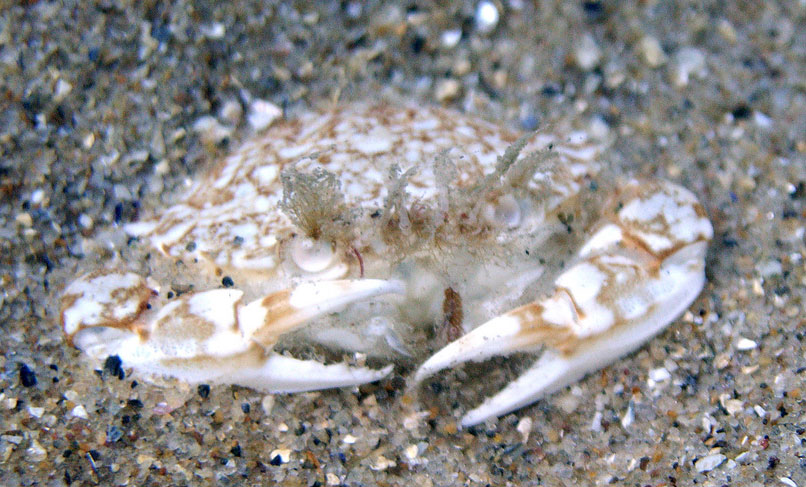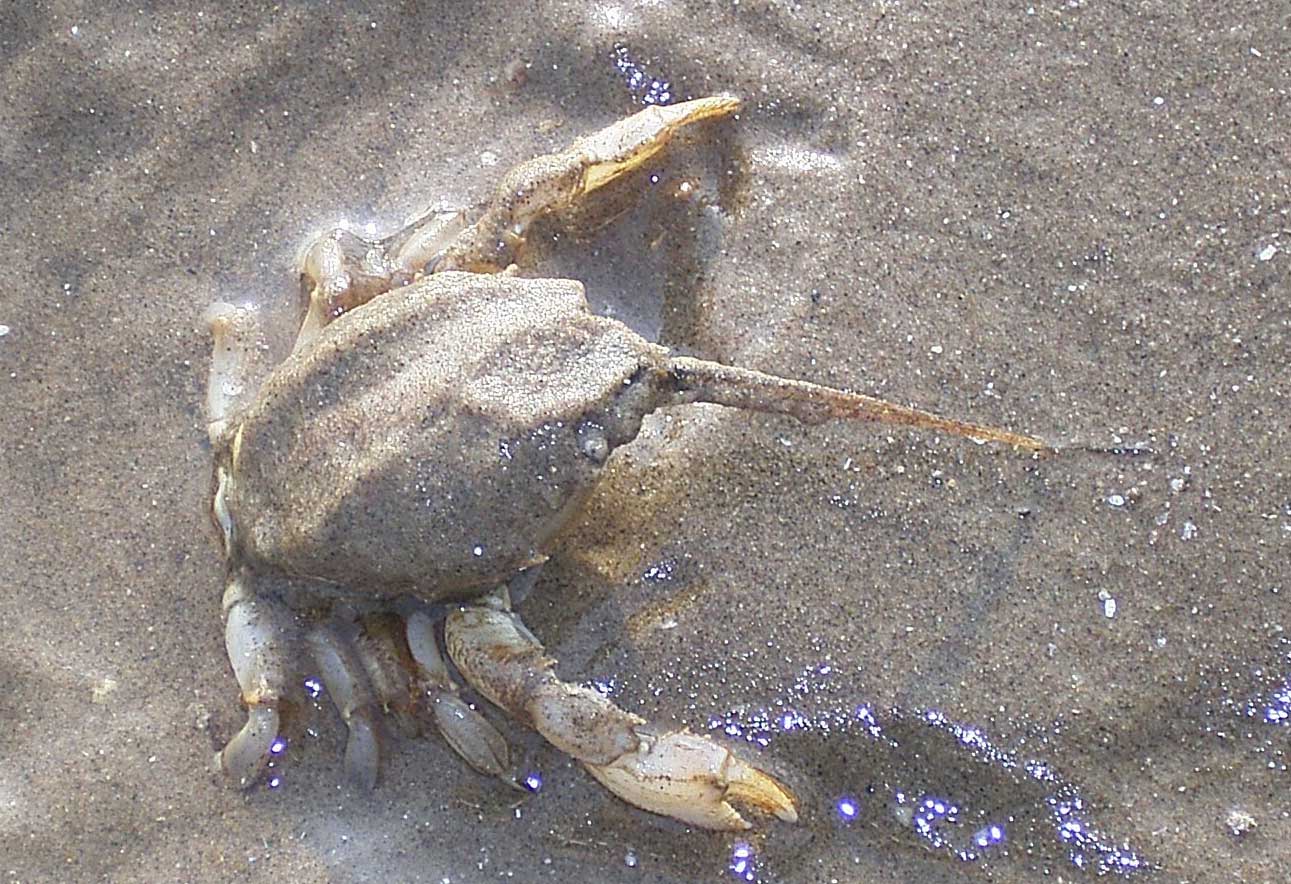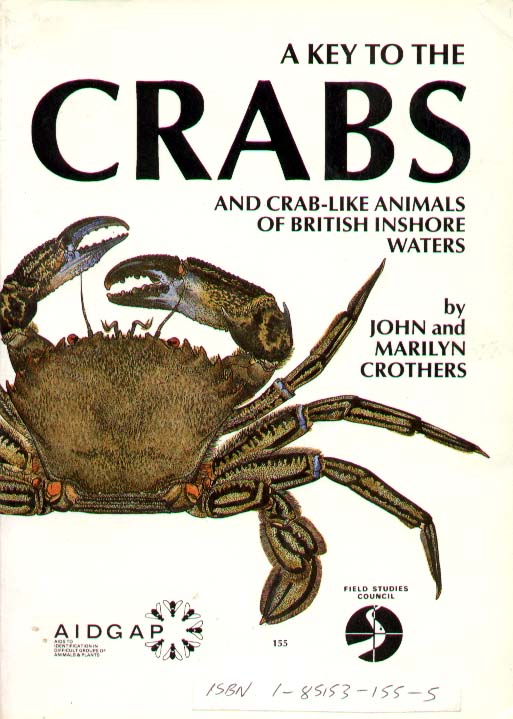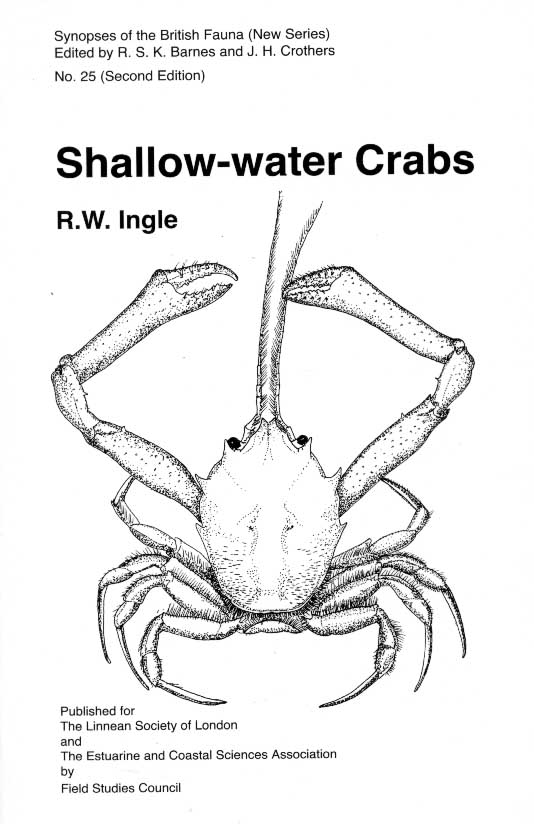 |
 |
Because that's the way their legs bend. This lets them squeeze into holes and crevices to keep out of the way of fish with sharp teeth and larger crabs that might think the crab was a tasty meal.
One of the first animals that you are likely to find on a visit to the coast is the crab. They can be found in many different shapes and sizes, scurrying across the sand at the approach of human feet. Look for them under stones and rocks and pieces of seaweed.
All crabs have ten legs, two of which have developed into very large and powerful claws, used for grasping their food and fighting each other. Crabs are very greedy and quarrelsome. They never seem to be satisfied with what they have. Even with a juicy worm in its crusty jaws, a large crab will try and steal food from another crab. In the numerous fights, they often lose one of their claws.
Crabs have two eyes perched on stalks that stick out from the hard shell, and a pair of small feelers between them. They are very common both on the shore and in the sea, with different species living in slightly different places and ways.
Crabs belong to a group of animals known as the Crustacea. The soft body is protected by a hard outside shell known as a exoskeleton. Unfortunately, this hard shell does not grow.
Instead, a soft shell grows inside the crab. Eventually, the crab grows too big and it has to shed its old hard shell. This process is called 'moulting' and it is a very dangerous time for the crab. The new shell is larger than the old one, but it is soft and takes time to harden.
While it remains soft, the crab tries to stay hidden so that it is not attacked by hungry fish and other animals. During the moult, the crab can grow back a lost claw, but it will be smaller than the one that was broken off.
The old discarded shell looks like a dead crab, but if you look closely you will find there are holes where the eyes should be. It is hollow inside and it will sometimes float to the surface where it may be washed ashore.
Reproduction
Female crabs often carry a clump of eggs on the underside of their body. They are cared for for several months before the eggs hatch into tiny swimming crab larvae which are released to take their chances in the sea. The larvae join the plankton, which is the masses of small plants and animals that live and grow in the surface waters of the sea.
After a few months, the larvae
that have survived fall to sea bottom and turn into tiny adult crabs. In
the summer hundreds can be found on rocky shores and in estuaries.
Shore
Crab Carcinus maenas
This is the crab that the visitor is most likely to see on the shore. They will be found in all sizes from tiny crabs just about visible to the naked eye to hand-sized crabs that look quite dangerous with their big claws and can injure anyone who gets his, or her, fingers in the way.
Most of the crabs are a mottled
brown colour which makes them difficult to see amongst the seaweeds. However,
about one in every twenty crabs is a bright green colour, and the small
crabs have lots of different patterns. Orange crabs are also found.
Edible Crab Cancer
pagurus
This is the red crab that fishmonger's sell for eating. The crab has a wide oval shell with a pie-crust edge. This crab will crouch under rocks, buried completely or with the top of their shell just visible. They are found low down on the shore near the sea. You are not allowed to collect them, as the crab must be allowed to grow big enough for eating.
The claws of the Edible Crab
are very strong, so it can crush open a mussel or a sea urchin.
Hairy Crab Pilumnus
hirtellus
 This
small crab is the same colour is the Edible Crab but if you look closely,
you can quickly tell the crabs apart because the Hairy Crab has hairs all
over its legs and shell. Also, its two claws are always different sizes.
This
small crab is the same colour is the Edible Crab but if you look closely,
you can quickly tell the crabs apart because the Hairy Crab has hairs all
over its legs and shell. Also, its two claws are always different sizes.
Velvet Swimming Crab, Necora puber
This is an attractive crab
with bright red eyes with a covering of very fine hair on the shell that
gives it a velvety texture. Beware, if you get that close or dip your hands
into a pool without looking, this crab can give you a nip that will bring
tears to your eyes.
 |
 |
 |
|
|
|
|
Usually only small crabs are found on the shore, but you will sometimes find one too big to lift up by a single hand. If you dare to pick it up, you must carefully grab the rear of the shell away from the claws. It looks a bit look like the Shore Crab. If you look closely you should be able to see that the rear legs are flattened so that it can swim a bit. In the Shore Crab, the rear legs are pointed like all the other legs for gripping on to rocks.
Velvet Swimming Crabs will
attack and eat smaller crabs.
Mass
Stranding 2011
The Sandy Swimming Crab,
Liocarcinus
depurator, is a sandy or orange coloured swimming crab that is
found over sandy ground, in the shallows just below low tide mark.

Sandy
Swimming Crab, Liocarcinus depurator
Arch-fronted Swimming Crab, Liocarcinus arcuatus (Report from Sussex intertidal)
Another swimming crab Liocarcinus
vernalis can be found in shallow water and on the shore on the
very low spring tides. Also the very small swimming crab Portumnus
latipes inhabits the sandy shallows and can be found on the shore
at low tide.
 |
 |
 |
|
|
|
|
Photograph by William Marriage of a specimen found on the Norfolk coast |
 |
Probably
Liocarcinus
marmoreus
This interesting photograph, taken off Lundy, small crab, empty shell. .. Photograph
by J D Hill on
flickr
|
Masked Crab Corystes
cassivelaunus
Not all crabs walk sideways. The Masked Crab burrows backwards into the sand to hide.
The two antennae between
its eyes are modified into a tube to inhale sea water for it to breathe.

Masked
Crab
|
 |
Dead Masked Crabs are washed up on sandy beaches, but to watch them alive you will have to dig down into the sand at a very low tide. Young Masked Crabs are often captured in shrimp-nets in the shallow seas over sand.
In the first picture above
by Ray
Winterborne the Masked Crabs were unovered by the receding tide
at Seascale in
Cumbria. The crabs were all around 3 to 4 cm in length, so they were juveniles.
 Small
Circular
Crabs, Atelecyclus,
are caught in
shrimp nets,
Small
Circular
Crabs, Atelecyclus,
are caught in
shrimp nets,
This crab, as its name suggests, has a shell the size of a pea. Or, at least the brown male Pea Crab has. This is the crab that can be seen swimming in estuaries over mussel beds. It the most active swimmer of all the British crabs.
The female is quite different. She is almost twice the size of the male and usually yellow with a bright red blob on its soft shell. She is hardly able to crawl and cannot swim.
She does not need to because
she spends her whole life inside in a live mussel shell. The male fertilises
her eggs by swimming inside the mussel when it opens to feed.
Short-legged Spider Crab
Eurynome aspera
Not all the crabs look the same. The spider crabs are a family of crabs that are roughly triangular in shape and have eight long legs as well as the two claws which are not quite as powerful as the other crabs. The claws are more like tools for extracting morsels of food out of small places.
All the spider crabs have
a tendency to decorate their shells with scraps of food to disguise their
appearance and fool fishes and other predators. The Short Legged Spider
Crab only grows to about 25 mm in shell length.
Eurynome
sp.
(left) & Hyas sp.(right)
Photograph
by David Wood (Shoreham Beach)
The identification of both species of crab has been confirmed.
It is not easy to spot and is often mistaken for a clump of weed. There are two, possibly three, British species. Pisa armata is rarely found between the tides. The specimen below was discovered and photographed by Robert Jones of Trowbridge.
Pisa nodipes
PisatetraodonandPIsa armata are the other species.
Long-legged Spider Crab
Macropodia
rostrata
As its name suggests this crab has very long legs. It has a very triangular shell and it looks like a Daddy Long-legs.
If it is caught in a net or stranded at low tide, it resembles a crumpled up twig. However, when under water it swims with a curious bicycle-like motion. It often places weed all over its legs and shell which gives it its other name of Decorator Crab. There are several species of crabs in the genus Macropodia and differentiating them is very tricky.
20
August 2001
A
small badly damaged specimen of the Scorpion
Spider Crab, Inachus phalangium, was my first confirmed record
from the Sussex shore, although it is frequently discovered in shallow
water offshore. This is a small species of long-legged crab that often
associates with sea anemones. (TQ
235 047)
This is a very large crab with a very spiny shell with lots of bumps and sharp bits. It grows quickly to 18 cm in length from between its two black eyes to its curved rear end.
It is much too big a crab to live on the shore all the year round, but in June are regular visitors at low tide on southern (English Channel) coasts, occasionally smaller specimens get washed ashore at other times of the year, or even larger ones thrown out by fishermen.
Nowadays, this crab is sometimes sold by fishmongers. Only the meat inside the claws is eaten.
Other species of crab are found on the shore and in the shallows off the west coast of Britain.
One of these is called the
Furrowed
Crab, Xantho
incisus. When disturbed this crab stretches its two large claws
out wide.
 |
|
This crab is only to be discovered off the southern and western coast of Britain where it can be common on suitable rocky shores Photograph by Bob Alexander |
This
crab has now had a change of scientific name
Click
on the image for more information
| The Runner Crab (or Square Crab), Goneplax rhomboides, is an offshore crab of muddy areas which is occasionally washed up on dead on the strandline. The crab (with a missing claw) in the photograph by Ade Jupp was found washed up at Hythe, Kent, on 24 December 2005. |  |
August 2006
This attractive crab was brought in by a potter from Milford Haven, south-west Wales. It is about 40 mm wide and is now alive and well in the Silent World Aquarium at Tenby. It is the species Monodaeus couchi which is seldom recorded and may be one of the rarer crabs from the seas around the British Isles.
27 August 2011
Hyas araneus
This crab has a missing leg
Click on the image for more information
There are many crab-like
animals to be found on the shore. The common species are:
 Hairy
Porcelain Crab Porcellana platycheles
Hairy
Porcelain Crab Porcellana platycheles
This is not a true crab, but with its flattened body clamped to the underside of a rock, it looks like one. It is small; you could hide underneath a 10 pence coin. The shell is covered in hair and the two large claws contain a fringe of hair.
If you look carefully, this
animal has only eight visible legs, including the claws.
Long-clawed Porcelain
Crab Pisidia longicornis
 |
This is an even smaller animal that will fit under a 5 pence coin. It clings to the underside of rocks with two long claws and six visible legs.
REPORTS:
A small number of fishermen on the Sussex coast are reporting catches of non-native American Lobster, Homarus americanus, and Dungeness Crabs, Metacarcinus magister, in an area in the vicinity of Brighton on the Sussex coast.
Captures
should be retained and it is illegal to return non-native species to the
sea. Report finds to to IFCA
or the MMO.
 |
 |
Dungeness
Crab
Photographs
by George Sutton
on
Fishing
News
facebook
This
crab was caught in nets off Brighton by George Sutton, who also caught
an American Lobster
on 19 June 2015.
BMLSS
Lobsters
 19
April 2010
19
April 2010
Recreational
angler Troy Waterman
discovered the third (and his second) British record of the alien Asian
Shore Crab, Hemigrapsus
sanguineus, on the southern end of
the west coast of Guernsey in the Channel Isands. It was a female and alive.
with a carapace width measured at 23 mm.
October
2010
Another
one of these crabs was reported from from the seashore at West Park, Jersey.
July
- September 2008
At
least six Chinese Mitten Crabs, Eriocheir
sinensis, were caught in the Humber
tributaries in the latter half of 2008. This
sudden speight of records in tidal tributaries of the Humber, represents
a sudden seasonal migration down to brackish waters in the lower Humber
estuary for spawning purpose.
Chinese Mitten Crabs, Eriocheir sinensis, have been confirmed as by-catch from white fish fisheries in the Dee estuary, north-west Wales.
Another
Columbus
Crab,
Planes minutus, was discovered
by crab potter Chris Marquis
near
Herm and Sark in the Channel Islands amongst a tray of Goose Barnacles.
November
2006
At
least two specimens of the large pelagic swimming crab known as Henslow's
Swimming Crab, Polybius henslowii,
were
brought in by a commercial fisherman from Poole Bay. This
crab is an active predator of small fish and is usually found over deep
water further south. The same weather conditions which have brought in
the By-the-wind Sailors are
likely to have blown this crab into the shallow bay.
Common Hermit Crab Pagurus
bernhardus
Pick up a sea snail crawling along the floor of rock pool and look carefully and you may spot the two tiny claws. This means that a Hermit Crab has taken up residence inside the shell.
The shell is a useful protection for the soft coiled end of its body.
The largest of the two claws is on the right one on the left when the crab is seen from the front.
Hermit Crabs are common between the tides on rocky shores. Large Hermit Crabs occupy the large shell of a whelk. A ragworm may live inside the shell as well and can be seen poking its head out of the shell when the crab feeds. Other animals like barnacles and even a sea anemone can sometimes be found living on the outside of the shell.
At least 15 species of hermit crabs are found in the seas around Britain. One species which I will call the South-claw Hermit Crab, Diogenes pugilator, has the largest claw as the left one, and is sometimes found on the sandy shallows, partly buried in the sediment, in the south-west.
Hermit
Crabs for the younger reader
Squat Lobster Galathea
squamifera
This is not a true crab or a true lobster. It looks like a crab with claws outstretched like a lobster. It lives in holes and under rocks and jumps backwards like a prawn when disturbed.
It will fit easily on the palm of your hand.
Occasionally, a true European Lobster, Homarus gammarus, can be found hiding under a large boulder on the shore or in the deeper pools.
28
February 2009
A
mutant Edible Crab, Cancer
pagurus, had
a lucky escape from the pot after fishermen discovered it had a three-pincered
claw. The creature has been named Ali and is being cared for by marine
experts at the Blue
Reef Aquarium in Hastings after being
hauled up in the fishermenís pots. As well as a normal pair of fully functional
15cm-long pincers, Ali has an extra appendage growing on his left claw.
Blue Reef curator Daniel Davies
said: ďItís certainly unusual. The mutation
is usually caused when the crab has moulted and
the body is soft.Crabs, like other crustaceans, are capable of re-growing
limbs and claws if they lose or damage them in a fight. So Aliís ability
to regenerate has got confused and, rather than just replacing a missing
set of claws, heís actually ended up growing an extra part instead."
References:

Key
to the Crabs and Crab-like Animals of British Inshore Waters by
John and Marilyn Crothers,
AIDGAP
Guide published by the Field Studies Council, and Richmond Publishing Company.
ISBN
1 85153 155 5.
FSC
Publications, Tel: 01743 850370
Field
Studies Council Publications

Shallow-water
Crabs
by
R W Ingle
Synopses
of the British Fauna (new Series)
Edited
by R S K Barnes and J H Crothers
Field
Studies Council
ISBN
1 85153 258 7
Further
Information:
Spanish
Crabs
|
|
|
|
|
News 2018 |
Membership Form |
|